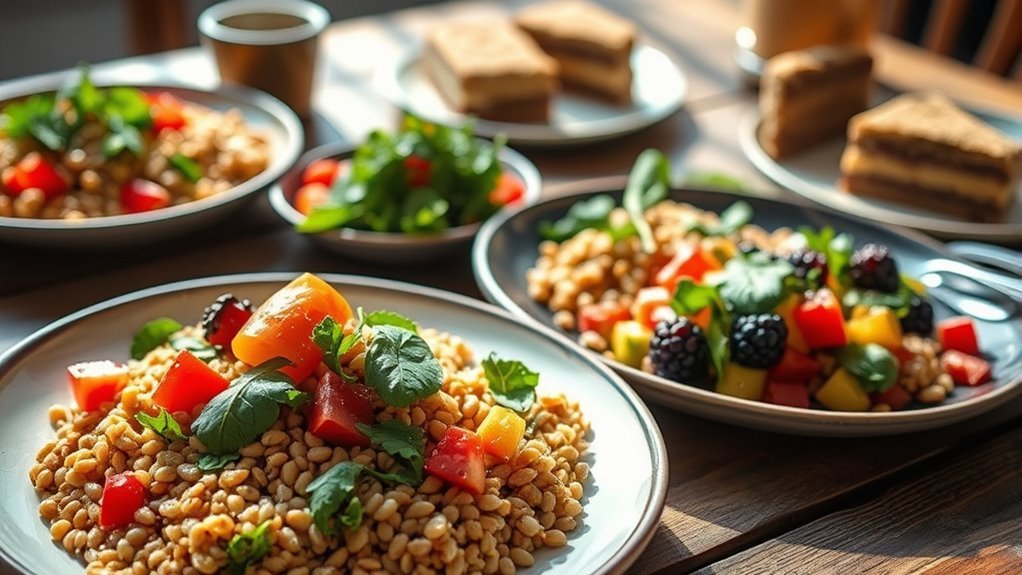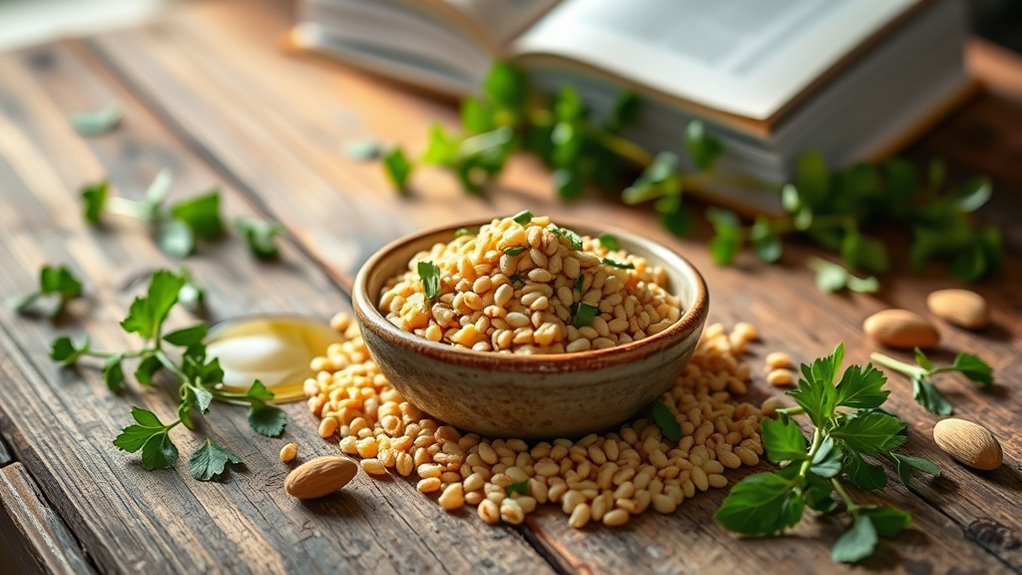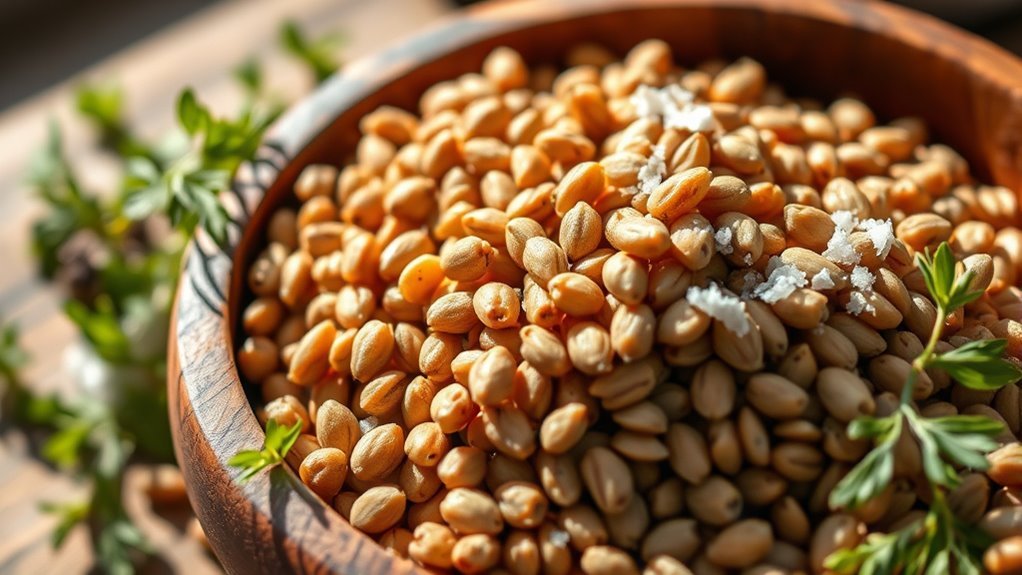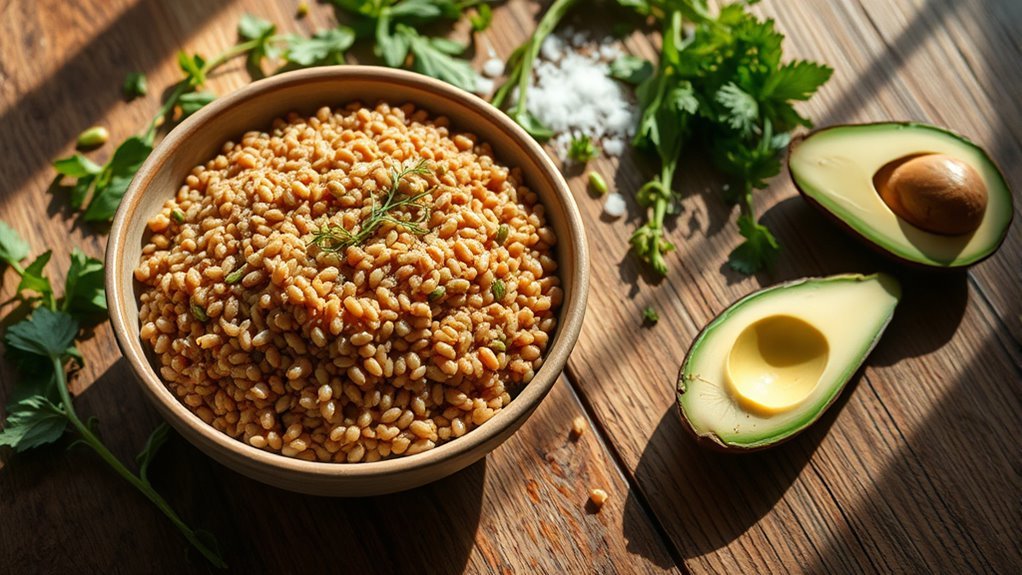Buckwheat isn’t typically considered keto-friendly due to its higher carbohydrate content, containing about 21 grams of carbs per 100 grams. This may exceed daily carb limits for strict ketogenic diets. However, if you’re flexible with your carb intake, small portions of buckwheat might fit into a more lenient approach. It’s crucial to monitor your overall carb consumption when including it. To learn more about how buckwheat can fit into your meals, keep exploring the options available.
Understanding Buckwheat: What Is It?

Buckwheat, despite its name, isn’t actually a type of wheat; it’s a seed derived from the Fagopyrum esculentum plant. This pseudocereal has a rich history, dating back to ancient times when it was cultivated in Asia and later spread to Europe. You’ll find that its culinary uses are diverse; it’s commonly ground into flour for pancakes, noodles, and porridge. Unlike traditional grains, buckwheat is gluten-free, making it a popular choice for those with dietary restrictions. Additionally, its nutty flavor and unique texture add variety to meals. Overall, understanding buckwheat’s historical significance and versatility in the kitchen can inspire you to explore new recipes while embracing a more liberated approach to food.
Nutritional Profile of Buckwheat

Packed with nutrients, buckwheat offers a compelling nutritional profile that makes it a significant addition to many diets. Its impressive nutrient density includes essential minerals like magnesium and copper, along with high-quality protein. Unlike many grains, buckwheat has a low glycemic index, which means it won’t spike your blood sugar levels, making it a potentially smart choice for those monitoring their carbohydrate intake. This property can enhance metabolic flexibility, allowing you more freedom in your dietary choices. Additionally, buckwheat is rich in antioxidants, which can support overall health. By incorporating buckwheat into your meals, you’re not just adding flavor; you’re also boosting your intake of crucial nutrients that contribute to a balanced, health-conscious lifestyle.
Carbohydrate Content and Keto Compatibility

When considering buckwheat’s compatibility with a keto diet, it is crucial to evaluate its carbohydrate content. With approximately 21 grams of carbs per 100 grams, buckwheat may exceed the typical daily carb limit for those on a strict ketogenic regimen. Understanding these nutritional aspects will help you make informed choices about incorporating buckwheat into your meals.
Buckwheat Nutritional Profile
Understanding the nutritional profile of buckwheat is essential for those considering a ketogenic diet. Buckwheat, despite its name, isn’t a grain but a seed, originating from East Asia. It comes in several varieties, including common buckwheat and Tartary buckwheat, each offering unique nutritional benefits. Typically, buckwheat contains around 20-25 grams of carbohydrates per 100 grams, which can challenge your keto goals, particularly if you’re aiming for strict carb limits. However, it also provides protein and dietary fiber, contributing to overall satiety. If you’re seeking alternatives, consider experimenting with lower-carb options or small portions of buckwheat while monitoring your daily intake. This way, you can enjoy its nutritional benefits without derailing your keto lifestyle.
Keto Diet Guidelines
While adhering to keto diet guidelines, it’s crucial to pay close attention to carbohydrate content, as this macronutrient directly influences your ability to maintain a state of ketosis. For effective keto meal planning and carb counting, consider these three key points:
- Daily Carb Limit: Aim for 20-50 grams of net carbs per day to stay in ketosis.
- Food Choices: Focus on low-carb vegetables, healthy fats, and moderate protein sources while avoiding grains and sugars.
- Monitoring: Regularly track your macros using apps or journals to verify you’re meeting your dietary goals.
Health Benefits of Buckwheat
Although some might think of buckwheat merely as a grain, it offers a range of health benefits that make it a valuable addition to any diet. For starters, buckwheat is rich in essential nutrients, including protein, fiber, and antioxidants, which contribute to overall well-being. One of the notable buckwheat benefits is its ability to help regulate blood sugar levels, thanks to its low glycemic index. This makes it a smart choice for those managing diabetes or looking to maintain energy levels. Additionally, the nutritional advantages of buckwheat include supporting heart health due to its high levels of flavonoids. Incorporating buckwheat into your meals can enhance your diet while promoting a sense of freedom in making healthier food choices.
Alternatives to Buckwheat on a Keto Diet
If you’re following a keto diet and looking for alternatives to buckwheat, you have several options that can still meet your nutritional needs without compromising your carbohydrate limits. Here are three great low carb substitutes you can consider:
- Almond Flour: This is one of the most popular keto grains, offering a nutty flavor and versatility in baking.
- Coconut Flour: Another excellent low carb substitute, it’s high in fiber and absorbs moisture well, making it great for thickening sauces.
- Chia Seeds: Packed with omega-3 fatty acids, chia seeds are low in carbs and can be used in puddings or as a thickening agent.
These alternatives can help you maintain your keto lifestyle while enjoying a variety of flavors and textures.
Incorporating Buckwheat Into Your Meals
Incorporating buckwheat into your meals can be both simple and rewarding. You can experiment with various cooking techniques, such as toasting or boiling, to enhance its nutty flavor and texture. Pairing buckwheat with protein-rich foods or low-carb vegetables can create satisfying dishes that align with your dietary goals.
Cooking Techniques for Buckwheat
When you’re looking to add buckwheat to your meals, understanding the right cooking techniques can make all the difference. Here are three effective cooking methods for creating delicious buckwheat recipes:
- Boiling: Rinse the buckwheat groats, then simmer them in water or broth for about 10-15 minutes until tender.
- Toasting: Before boiling, toast the groats in a dry skillet for a nuttier flavor. This enhances the overall taste of your dishes.
- Baking: Incorporate cooked buckwheat into baked goods like muffins or pancakes, adding a nutritious twist to your favorite recipes.
Using these techniques can elevate your meals, ensuring that you enjoy the versatility and health benefits of buckwheat while maintaining your dietary goals.
Meal Pairing Suggestions
Buckwheat’s unique flavor and texture make it a versatile ingredient that can complement a variety of dishes. You can pair cooked buckwheat with grilled chicken or fish for a nutritious main course, enhancing the meal combinations with fresh herbs or zesty lemon. Alternatively, consider incorporating it into a hearty vegetable stir-fry for a satisfying plant-based option. As a side dish, buckwheat can shine by tossing it with roasted vegetables and a drizzle of olive oil, creating a delicious accompaniment. Don’t forget to sprinkle some feta or goat cheese on top for added creaminess. Whether you’re looking for a base or a side, buckwheat’s adaptability allows you to explore countless culinary possibilities while maintaining your keto-friendly lifestyle.
Making Informed Choices: Should You Include Buckwheat?
How can you determine whether buckwheat fits into your keto lifestyle? It’s essential to sift through nutritional misconceptions and focus on your dietary preferences. Buckwheat is technically a seed and not a grain, but it’s relatively high in carbs, which can challenge keto principles. Here are three factors to evaluate:
Determining if buckwheat fits your keto lifestyle requires examining its carb content and your dietary goals.
- Net Carbs: Calculate the net carbs in your serving. A typical serving may have around 22g, which can exceed your daily limit.
- Nutritional Benefits: Assess the fiber, protein, and micronutrients that buckwheat offers, which can support your overall health.
- Personal Goals: Reflect on your keto goals. If flexibility allows for occasional higher-carb options, buckwheat might be a suitable choice.
Frequently Asked Questions
Can Buckwheat Be Consumed on a Strict Ketogenic Diet?
When considering whether buckwheat can fit into a strict ketogenic diet, you’ll need to look at its nutrition. Buckwheat is relatively high in carbohydrates compared to typical ketogenic alternatives. While it provides essential nutrients, its carb content might disrupt ketosis for many. If you’re aiming for strict adherence to keto, focusing on lower-carb options like leafy greens or cauliflower could be a better choice. Always weigh your dietary goals against buckwheat’s nutritional profile.
How Does Buckwheat Affect Blood Sugar Levels?
Imagine a gentle river flowing, symbolizing balance in your body. When it comes to buckwheat, its moderate glycemic index means it doesn’t spike your blood sugar dramatically, allowing for steadier energy levels. Compared to refined grains, buckwheat’s impact on blood sugar is less turbulent, offering a nourishing option for those seeking stability. You can enjoy its benefits while maintaining control over your body’s responses, embracing a sense of freedom in your dietary choices.
Is Buckwheat Gluten-Free?
Yes, buckwheat is gluten-free, making it a great option for those with gluten sensitivities or celiac disease. Its nutritional profile is rich in fiber, protein, and essential minerals, offering numerous health benefits. By incorporating buckwheat into your diet, you can enjoy a versatile grain that supports digestive health and provides sustained energy. Whether you’re making pancakes or salads, it’s a delicious choice that aligns with a gluten-free lifestyle.
What Are the Best Cooking Methods for Buckwheat?
When cooking buckwheat, you’ve got some great options. For a hearty breakfast, consider making buckwheat porridge; just simmer it in water or milk until tender, adding fruits or nuts for flavor. Another fantastic choice is buckwheat pancakes—combine flour with eggs, milk, and a pinch of salt, then cook on a skillet. Both methods preserve its nutty flavor while providing a nutritious meal. Enjoy experimenting with these versatile and wholesome dishes!
Can Buckwheat Be Used in Desserts on a Keto Diet?
Imagine a canvas where creativity meets culinary delight: buckwheat desserts can indeed be a delicious option on a keto diet. While traditional recipes might not fit, you can use buckwheat flour sparingly as a base and combine it with keto substitutes like almond flour or coconut flour. This way, you’re crafting treats that satisfy your sweet tooth while keeping carb counts low. Just be mindful of portion sizes to maintain your keto goals.


